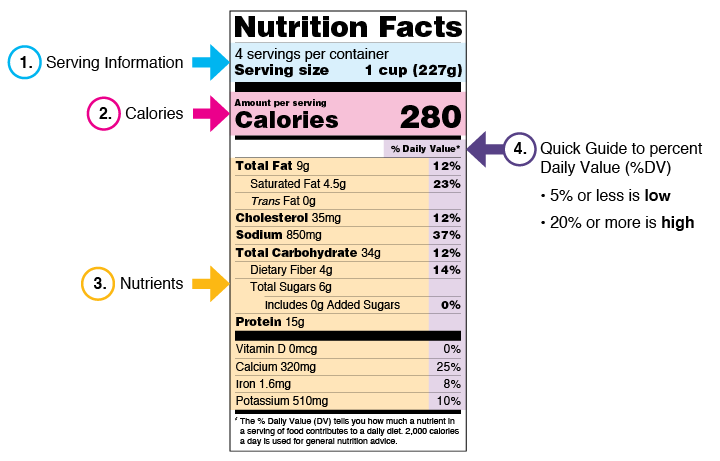
By Kristin Neusel, MS, RD, LD, CDCES
Label reading can be super tricky!
There’s a lot of information, and selecting the right product can be a daunting task.
I’m going to give you a brief overview of:
- How to read the nutrition facts label
- What to look for when comparing items
- Some tips for carb counting!
As an example, here is a nutrition label from the FDA:

Serving information
I always recommend people look at this to compare the serving size listed on the label to what they are eating.
For example, if you are eating 2 cups of the above lasagna, you’ll need to double all of the nutrition information because the information listed above is for 1 cup.
The number in parenthesis is just the weight of the serving size if you were to put it on a scale. When comparing items, if one label lists the serving size in cups and another in ounces, comparing the number in parentheses is going to be helpful to ensure you are comparing “apples to apples”.
Calories
If you’re the type of person who likes to count calories, this will be an important section for you to focus on.
To maintain a healthy body weight, you’ll want to balance the number of calories you eat and drink with the number of calories you burn.
A general guideline is 2,000 calories per day, but it’s best to have a registered dietitian provide an individualized assessment of your specific calorie needs.
Nutrients
Depending on what you’re looking for—e.g. whether you are focusing on limiting your sodium intake or watching how many carbohydrates you consume—this will be the section in which you you can find that.
For managing blood sugars, the most important information to focus on will be the carbohydrates section.
Listed under carbohydrates, it is broken down into different types of carbohydrates:
- Total dietary fiber
- Total sugar, and
- Newly added total added sugar
If you are concerned about your gut-microbiome health, you’ll want to look for food items that have a higher fiber intake (remember, fiber carbohydrates do not impact your blood-sugar levels and actually help slow the absorption of glucose) and lower added sugar amount.
Tip alert: To calculate “net carbohydrates,” simply subtract the total grams of fiber and sugar alcohols (if included and listed) from your total carbohydrates.
If you are counting carbohydrates, this will be important and you are able to subtract these because neither fiber nor sugar alcohols impact your blood sugars.
For instance, the label above has 34 grams of carbohydrates and 4 grams of fiber. You can subtract 4 from 34 to give you a total “net carbohydrates” of 30.
What to look for: Serving size, total grams of carbohydrates, total grams of fiber
What to eat less of: Saturated fats, sodium, added sugars
What to eat more of: Dietary fiber, vitamin D, calcium, iron, potassium
Percent Daily Value
The % daily value (%DV) is the percentage of the daily value for each nutrient in a serving of that food.
It shows how much a nutrient in a serving of food contributes to a total daily diet, and can help you determine if a serving of food is high or low in a nutrient.
Keep in mind that these are based on a 2000-calorie diet, so these percentages will not be accurate for everyone.
As a general guide, 5% DV or less of a nutrient is considered low, and 20% DV or more is considered high. Some items, like trans fat and protein, don’t always have % DV.
What to look for when comparing items
1. If you’re debating between a few items, pick up the labels, and read them.
Look for items with more fiber and less added sugars.
When people with Type 2 diabetes ask me what to look for on the label, I recommend these 3 things:
- Serving size
- Total grams of carbohydrates, and
- Total grams of fiber
2. Sometimes, when products cut out fat, they increase sugar or salt.
Compare a few items and look for the product that is the better choice depending on the macronutrient/ingredient you are focusing on.
I always recommend to people that they “read it before they eat it!”. It can be tricky at first but will become second nature after a little bit of practice.
For items that don’t have a label, like fresh fruits and vegetables, I suggest using the app or website Calorie King.
Talk to a registered dietitian
Whether it's label reading, curiosity around a gut-microbiome healthy eating plan, or questions you might have about medical probiotics like Pendulum Akkermansia or Pendulum Glucose Control, talk to one of Pendulum's registered dietitians. They can be reached by clicking here.
Also, be sure to stay on top of your health by following Pendulum on social media at the following sites:
LinkedIn
Facebook
Instagram
Twitter
TikTok
Interested in submitting a question to Kristin? Email it to her at nutrition@pendulumlife.com and we’ll try to answer it in an upcoming post!